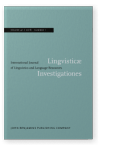Vol. 41:1 (2018) ► pp.111–128
On negative indefinites in Gallo
Evidence for non-intrinsically negative (scalar) negation
This paper brings to bear primary fieldwork data from Gallo on negation and polarity related issues. We defend two correlated proposals. (i) The negative markers pas/pouint in Gallo are not inherently negative, but rather merely signal the presence of abstract semantic negation in their clause. (ii) In (at least) the Morbihan dialect of Gallo, the negative markers pas/pouint come in two variants: a plain and a scalar variant, both of which enter into a Negative Concord relation with abstract semantic negation. The scalar NPI variant corresponding to aoqhun across other Gallo dialects, or to aucun in Standard French, is pas/pouint aoqhun and it is the negator (minimizer) pas/pouint that provides the necessary scalarity component characteristic of N(P)Is (formally the scalar feature [+σ]) to the plain indefinite aoqhun. As a corollary, adapting Labelle & Espinal (2014), the shift from indefinite to (N)PI involves transfer of a scalar feature from a minimizer to an indefinite.
Article outline
- Introduction
- 1.Negative indefinites in French
- 2.Negative Concord in Gallo
- 3.On the status of pas and pouint in Gallo
- 3.1Non-intrinsically negative negation
- 3.2Scalar negation
- 4.Conclusion
- Acknowledgements
- Notes
-
References
